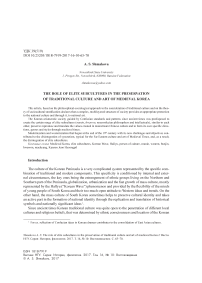The role of elite subcultures in the preservation of traditional culture and art of medieval Korea
Автор: Shmakova A.S.
Журнал: Вестник Новосибирского государственного университета. Серия: История, филология @historyphilology
Рубрика: Этнология и религия Азии
Статья в выпуске: 10 т.16, 2017 года.
Бесплатный доступ
This article, based on the philosophical-sociological approach to the consideration of traditional culture and on the theory of sociocultural stratification declares that a complex, multilayered structure of society provides an appropriate protection to the national culture and through it, to national art. The Korean aristocratic society guided by Confucian standards and patterns since ancient times was predisposed to create the certain range of elite subcultures (munin, hwawon, neoconfucian philosophers and intellectuals), similar to each other, preset to reproduce and translate the values created in mainstream Chinese culture and to form its own specific directions, genres and styles through medieval times. Modernization and westernization that began at the end of the 19th century with its new challenges and objectives contributed to the disintegration of syncretism, typical for the Far Eastern culture and art of Medieval Times, and, as a result, the disintegration of elite subcultures.
Medieval korea, elite subcultures, korean wave, hallyu, person of culture, munin, wenren, bunjin, hwawon, maehyang, kanson jeon hyeongpil
Короткий адрес: https://sciup.org/147219717
IDR: 147219717 | DOI: 10.25205/1818-7919-2017-16-10-65-70
Список литературы The role of elite subcultures in the preservation of traditional culture and art of medieval Korea
- Guksa pyeonchan wiwonhoe. Geundaewa mannan misulgwa dosi [근대와 만난 미술과 도시. 서울: 두산동아]. City and art on the threshold of modernity. Seoul: Dusantonga, 2008. 352 p. (in Kor.)
- Kireeva L. I. About study of artistic value of Korean art in Western countries // Proceedings of the Center for Korean language and culture. S.-Petersburg, 2005. p. 187-191. (in Russ.)
- Sokolov K. B. Artistic life of the modern society. Subcultures and ethnic groups in artistic life. Saint-Petersburg, 1996. vol. 1. 237 p. (in Russ.)
- Tikhonov V. M., Kang Mangil. History of Korea. Vol. 1: from the earliest times to 1904. Moscow: Natalis, 2011. 533 p. (in Russ.)
- Volkov S. V. On some features of the social structure of the Medieval Korea // Russian Korean Studies. Almanac. Iss. 3. M., 2003. p. 113-126. The same // Proceedings of the Institute of Practical Oriental Studies. M., 2005. vol. 1. p. 181-199. (in Russ.)
- Voytishek E. E. Game traditions in the spiritual culture of East Asia countries (China, Korea, Japan). Novosibirsk: Novosibirsk State University Press, 2011. 312 p. (in Russ.)
- Voytishek E. E., Shmakova A. S., Bae Kidong. Incense burial ritual 埋香 maehyang in the southern part of the Korean Peninsula: problems of reconstruction // Bulletin of Novosibirsk State Pedagogical University. 2016. vol. 6. p. 32-52. (in Russ.)


